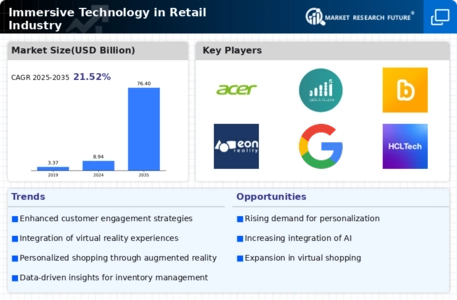-
Executive summary
-
Market Introduction
-
Definition
-
Scope of the Study
- Research Objective
- Limitations
-
Assumptions
-
Research Methodology
-
Overview
-
Data Mining
-
Secondary Research
-
Primary Research
- Breakdown of Primary Respondents
-
Primary Interviews and Information Gathering Process
-
Forecasting Modality
-
Market Size Estimation
- Top-Down Approach
-
Bottom-Up Approach
-
Data Triangulation
-
Validation
-
Market Dynamics
-
Overview
-
Drivers
-
Restraints
-
Opportunities
-
Market Factor Analysis
-
Value Chain Analysis
- Bargaining Power of Suppliers
- Threat of New Entrants
- Threat
- Intensity of Rivalry
-
Porter’s Five Forces Analysis
-
Bargaining Power of Buyers
-
of Substitutes
-
COVID-19 Impact Analysis
- Market Impact Analysis
- Regional Impact
- Opportunity
-
and Threat Analysis
-
GLOBAL Immersive Technology in Education sector MARKET,
-
BY Component
-
Overview
-
Hardware
- Head-Mounted Display (HMD)
- Projectors & Display Walls (PDW)
-
Gesture Tracking Devices (GTD)
-
Software/Platform
-
Services
- Professional
- Managed
-
GLOBAL Immersive Technology in Education sector MARKET, BY Technology
-
Overview
-
Mixed Reality (MR)
-
Virtual Reality (VR)
-
Augmented Reality (AR)
-
360 Film
-
GLOBAL Immersive Technology
-
in Education sector MARKET, BY Application
-
Overview
-
Training
-
& Learning
-
Emergency Services
-
Product Development
-
Sales & Marketing
-
GLOBAL Immersive Technology in Education sector MARKET,
-
by Region
-
Overview
-
North America
- U.S.
- Canada
- Germany
- France
- U.K
- Italy
- Rest of Europe
-
Europe
-
Spain
-
Asia-Pacific
- China
- India
- South Korea
- Australia
- Rest of Asia-Pacific
- Middle East
- Africa
- Latin America
-
Japan
-
Rest of the World
-
Competitive Landscape
-
Overview
-
Competitive Analysis
-
Market Share Analysis
-
Major Growth Strategy in the Global Immersive Technology
-
in Education sector Market,
-
Competitive Benchmarking
-
Leading
-
Players in Terms of Number of Developments in the Global Immersive Technology in
-
Education sector Market,
-
Key developments and Growth Strategies
- Merger & Acquisitions
-
New Component Launch/Technology Application
-
Joint Ventures
-
Major Players Financial Matrix
- Sales & Operating
- Major Players R&D Expenditure. 2022
-
Income, 2022
-
Company
-
ProfileS
-
ACER INC.
- Company Overview
- Financial Overview
- Key Developments
- SWOT Analysis
-
Product Offered
-
Key Strategies
-
Atheer, Inc.
- Company Overview
- Product Offered
- Key Developments
- Key Strategies
-
Financial Overview
-
SWOT Analysis
-
AVEVA Group PLC
- Financial Overview
- Product Offered
- SWOT Analysis
- Key Strategies
- Company Overview
- Financial Overview
- Key Developments
- SWOT Analysis
-
Company Overview
-
Key Developments
-
Barco NV
-
Product Offered
-
Key Strategies
-
Blippar Ltd.
- Company Overview
- Product Offered
- Key Developments
- Key Strategies
-
Financial Overview
-
SWOT Analysis
-
Carl Zeiss AG
- Financial Overview
- Product Offered
- SWOT Analysis
- Key Strategies
- Company Overview
- Financial Overview
- Key Developments
- SWOT Analysis
-
Company Overview
-
Key Developments
-
CM Labs Simulations Inc.
-
Product Offered
-
Key Strategies
-
EON Reality, Inc.
- Company Overview
- Product Offered
- Key Developments
- Key Strategies
-
Financial Overview
-
SWOT Analysis
-
FAAC Incorporated
- Financial Overview
- Product Offered
- SWOT Analysis
- Key Strategies
- Company Overview
- Financial Overview
- Key Developments
- SWOT Analysis
-
Company Overview
-
Key Developments
-
Google, LLC
-
Product Offered
-
Key Strategies
-
HCL Technologies Limited
- Company Overview
- Product Offered
- Key Developments
- Key Strategies
-
Financial Overview
-
SWOT Analysis
-
Honeywell International,
- Company Overview
- Financial Overview
- Key Developments
- SWOT Analysis
-
Inc.
-
Product Offered
-
Key Strategies
-
HTC Corporation
- Company Overview
- Product Offered
- Key Developments
- Key Strategies
-
Financial Overview
-
SWOT Analysis
-
Immersive Media Company
- Financial Overview
- Product Offered
- SWOT Analysis
- Key Strategies
- Company Overview
- Product Offered
- Key Developments
- Key Strategies
-
Company Overview
-
Key Developments
-
Immersive Technologies Pty Limited
-
Financial Overview
-
SWOT Analysis
-
Lockheed Martin Corporation
- Financial Overview
- Product Offered
- SWOT Analysis
- Key Strategies
- Company Overview
- Financial Overview
- Key Developments
- SWOT Analysis
-
Company Overview
-
Key Developments
-
Magic Leap, Inc.
-
Product Offered
-
Key Strategies
-
NCTech Limited
- Company Overview
- Product Offered
- Key Developments
- Key Strategies
-
Financial Overview
-
SWOT Analysis
-
Oculus (Facebook Technologies,
- Company Overview
- Financial Overview
- Key Developments
- SWOT Analysis
-
LLC.)
-
Product Offered
-
Key Strategies
-
Samsung Group
- Company Overview
- Product Offered
- Key Developments
- Key Strategies
-
Financial Overview
-
SWOT Analysis
-
Sony Corporation
- Financial Overview
- Product Offered
- SWOT Analysis
- Key Strategies
- Company Overview
- Financial Overview
- Key Developments
- SWOT Analysis
-
Company Overview
-
Key Developments
-
Unity Software Inc.
-
Product Offered
-
Key Strategies
-
Varjo Technologies Oy
- Company Overview
- Product Offered
- Key Developments
- Key Strategies
-
Financial Overview
-
SWOT Analysis
-
VI-grade GmbH
- Financial Overview
- Product Offered
- SWOT Analysis
- Key Strategies
- Company Overview
- Financial Overview
- Key Developments
- SWOT Analysis
-
Company Overview
-
Key Developments
-
Zeality Inc.
-
Product Offered
-
Key Strategies
-
Appendix
-
References
-
Related Reports
-
LIST
-
OF TABLES
-
Global Immersive Technology in Education sector Market, Synopsis,
-
Global Immersive Technology in Education sector Market, Estimates
-
& Forecast, 2018-2032 (USD BILLION)
-
GLOBAL Immersive Technology
-
in Education sector MARKET, BY Component, 2018-2032 (USD BILLION)
-
TABLE 4
-
GLOBAL Immersive Technology in Education sector MARKET, BY TECHNOLOGY, 2018-2032
-
(USD BILLION)
-
GLOBAL Immersive Technology in Education sector MARKET,
-
BY APPLICATION, 2018-2032 (USD BILLION)
-
North America Immersive Technology
-
in Education sector MARKET, BY Component, 2018-2032 (USD BILLION)
-
TABLE 7
-
North America Immersive Technology in Education sector MARKET, BY TECHNOLOGY, 2018-2032
-
(USD BILLION)
-
North America Immersive Technology in Education sector
-
MARKET, BY APPLICATION, 2018-2032 (USD BILLION)
-
North America Immersive
-
Technology in Education sector MARKET, BY Country, 2018-2032 (USD BILLION)
-
TABLE
-
U.S. Immersive Technology in Education sector MARKET, BY Component, 2018-2032
-
(USD BILLION)
-
U.S. Immersive Technology in Education sector MARKET,
-
BY TECHNOLOGY, 2018-2032 (USD BILLION)
-
U.S. Immersive Technology in
-
Education sector MARKET, BY APPLICATION, 2018-2032 (USD BILLION)
-
TABLE 13
-
Canada Immersive Technology in Education sector MARKET, BY Component, 2018-2032
-
(USD BILLION)
-
Canada Immersive Technology in Education sector MARKET,
-
BY TECHNOLOGY, 2018-2032 (USD BILLION)
-
Canada Immersive Technology
-
in Education sector MARKET, BY APPLICATION, 2018-2032 (USD BILLION)
-
TABLE 16
-
Europe Immersive Technology in Education sector MARKET, BY Component, 2018-2032
-
(USD BILLION)
-
Europe Immersive Technology in Education sector MARKET,
-
BY TECHNOLOGY, 2018-2032 (USD BILLION)
-
Europe Immersive Technology
-
in Education sector MARKET, BY APPLICATION, 2018-2032 (USD BILLION)
-
TABLE 19
-
Europe Immersive Technology in Education sector MARKET, BY Country, 2018-2032 (USD
-
BILLION)
-
Germany Immersive Technology in Education sector MARKET, BY Component,
-
Germany Immersive Technology in Education
-
sector MARKET, BY TECHNOLOGY, 2018-2032 (USD BILLION)
-
Germany Immersive Technology
-
in Education sector MARKET, BY APPLICATION, 2018-2032 (USD BILLION)
-
TABLE 23
-
France Immersive Technology in Education sector MARKET, BY Component, 2018-2032
-
(USD BILLION)
-
France Immersive Technology in Education sector MARKET,
-
BY TECHNOLOGY, 2018-2032 (USD BILLION)
-
France Immersive Technology
-
in Education sector MARKET, BY APPLICATION, 2018-2032 (USD BILLION)
-
TABLE 26
-
Italy Immersive Technology in Education sector MARKET, BY Component, 2018-2032 (USD
-
BILLION)
-
Italy Immersive Technology in Education sector MARKET, BY TECHNOLOGY,
-
Italy Immersive Technology in Education
-
sector MARKET, BY APPLICATION, 2018-2032 (USD BILLION)
-
Spain Immersive Technology
-
in Education sector MARKET, BY Component, 2018-2032 (USD BILLION)
-
TABLE 30
-
Spain Immersive Technology in Education sector MARKET, BY TECHNOLOGY, 2018-2032
-
(USD BILLION)
-
Spain Immersive Technology in Education sector MARKET,
-
BY APPLICATION, 2018-2032 (USD BILLION)
-
U.K Immersive Technology in
-
Education sector MARKET, BY Component, 2018-2032 (USD BILLION)
-
TABLE 33
-
U.K Immersive Technology in Education sector MARKET, BY TECHNOLOGY, 2018-2032 (USD
-
BILLION)
-
U.K Immersive Technology in Education sector MARKET, BY APPLICATION,
-
Rest of Europe Immersive Technology in
-
Education sector MARKET, BY Component, 2018-2032 (USD BILLION)
-
TABLE 36
-
Rest of Europe Immersive Technology in Education sector MARKET, BY TECHNOLOGY, 2018-2032
-
(USD BILLION)
-
Rest of Europe Immersive Technology in Education sector
-
MARKET, BY APPLICATION, 2018-2032 (USD BILLION)
-
Asia Pacific Immersive
-
Technology in Education sector MARKET, BY Component, 2018-2032 (USD BILLION)
-
TABLE
-
Asia Pacific Immersive Technology in Education sector MARKET, BY TECHNOLOGY,
-
Asia Pacific Immersive Technology in Education
-
sector MARKET, BY APPLICATION, 2018-2032 (USD BILLION)
-
Asia Pacific Immersive
-
Technology in Education sector MARKET, BY Country, 2018-2032 (USD BILLION)
-
TABLE
-
Japan Immersive Technology in Education sector MARKET, BY Component, 2018-2032
-
(USD BILLION)
-
Japan Immersive Technology in Education sector MARKET,
-
BY TECHNOLOGY, 2018-2032 (USD BILLION)
-
Japan Immersive Technology
-
in Education sector MARKET, BY APPLICATION, 2018-2032 (USD BILLION)
-
TABLE 45
-
China Immersive Technology in Education sector MARKET, BY Component, 2018-2032 (USD
-
BILLION)
-
China Immersive Technology in Education sector MARKET, BY TECHNOLOGY,
-
China Immersive Technology in Education
-
sector MARKET, BY APPLICATION, 2018-2032 (USD BILLION)
-
India Immersive Technology
-
in Education sector MARKET, BY Component, 2018-2032 (USD BILLION)
-
TABLE 49
-
India Immersive Technology in Education sector MARKET, BY TECHNOLOGY, 2018-2032
-
(USD BILLION)
-
India Immersive Technology in Education sector MARKET,
-
BY APPLICATION, 2018-2032 (USD BILLION)
-
Australia Immersive Technology
-
in Education sector MARKET, BY Component, 2018-2032 (USD BILLION)
-
TABLE 52
-
Australia Immersive Technology in Education sector MARKET, BY TECHNOLOGY, 2018-2032
-
(USD BILLION)
-
Australia Immersive Technology in Education sector
-
MARKET, BY APPLICATION, 2018-2032 (USD BILLION)
-
south korea Immersive
-
Technology in Education sector MARKET, BY Component, 2018-2032 (USD BILLION)
-
TABLE
-
south korea Immersive Technology in Education sector MARKET, BY TECHNOLOGY, 2018-2032
-
(USD BILLION)
-
south korea Immersive Technology in Education sector
-
MARKET, BY APPLICATION, 2018-2032 (USD BILLION)
-
Rest of asia-pacific
-
Immersive Technology in Education sector MARKET, BY Component, 2018-2032 (USD BILLION)
-
TABLE
-
Rest of asia-pacific Immersive Technology in Education sector MARKET, BY TECHNOLOGY,
-
Rest of asia-pacific Immersive Technology
-
in Education sector MARKET, BY APPLICATION, 2018-2032 (USD BILLION)
-
TABLE 60
-
Rest of WOrld Immersive Technology in Education sector MARKET, BY Component, 2018-2032
-
(USD BILLION)
-
Rest of WOrld Immersive Technology in Education sector
-
MARKET, BY TECHNOLOGY, 2018-2032 (USD BILLION)
-
Rest of WOrld Immersive
-
Technology in Education sector MARKET, BY APPLICATION, 2018-2032 (USD BILLION)
-
TABLE
-
Rest of WOrld Immersive Technology in Education sector MARKET, BY Country, 2018-2032
-
(USD BILLION)
-
Middle east Immersive Technology in Education sector
-
MARKET, BY Component, 2018-2032 (USD BILLION)
-
Middle east Immersive
-
Technology in Education sector MARKET, BY TECHNOLOGY, 2018-2032 (USD BILLION)
-
TABLE
-
Middle east Immersive Technology in Education sector MARKET, BY APPLICATION,
-
Africa Immersive Technology in Education
-
sector MARKET, BY Component, 2018-2032 (USD BILLION)
-
Africa Immersive Technology
-
in Education sector MARKET, BY TECHNOLOGY, 2018-2032 (USD BILLION)
-
TABLE 69
-
Africa Immersive Technology in Education sector MARKET, BY APPLICATION, 2018-2032
-
(USD BILLION)
-
Latin america Immersive Technology in Education sector
-
MARKET, BY Component, 2018-2032 (USD BILLION)
-
Latin america Immersive
-
Technology in Education sector MARKET, BY TECHNOLOGY, 2018-2032 (USD BILLION)
-
TABLE
-
Latin america Immersive Technology in Education sector MARKET, BY APPLICATION,
-
LIST OF FIGURES
-
Research Process
-
FIGURE
-
Market Structure for the Global Immersive Technology in Education sector Market
-
FIGURE
-
Market Dynamics for the Global Immersive Technology in Education sector Market
-
FIGURE
-
Global Immersive Technology in Education sector Market, Share (%), BY Component,
-
Global Immersive Technology in Education sector Market, Share
-
(%), BY TECHNOLOGY, 2022
-
Global Immersive Technology in Education
-
sector Market, Share (%), BY APPLICATION, 2022
-
Global Immersive Technology
-
in Education sector Market, Share (%), by Region, 2022
-
north AMERICA: Immersive
-
Technology in Education sector MARKET, SHARE (%), BY REGION, 2022
-
FIGURE 9
-
Europe: Immersive Technology in Education sector MARKET, SHARE (%), BY REGION, 2022
-
FIGURE
-
Asia-Pacific: Immersive Technology in Education sector MARKET, SHARE (%), BY
-
REGION, 2022
-
Rest of the world: Immersive Technology in Education
-
sector MARKET, SHARE (%), BY REGION, 2022
-
Global Immersive Technology
-
in Education sector Market: Company Share Analysis, 2022 (%)
-
ACER INC.: FINANCIAL
-
OVERVIEW SNAPSHOT
-
ACER INC.: SWOT ANALYSIS
-
Atheer, Inc.: FINANCIAL
-
OVERVIEW SNAPSHOT
-
Atheer, Inc., Inc.: SWOT ANALYSIS
-
FIGURE 17
-
AVEVA Group PLC.: FINANCIAL OVERVIEW SNAPSHOT
-
AVEVA Group PLC: SWOT
-
ANALYSIS
-
Barco NV: FINANCIAL OVERVIEW SNAPSHOT
-
Barco NV: SWOT ANALYSIS
-
FIGURE
-
Blippar Ltd.: FINANCIAL OVERVIEW SNAPSHOT
-
Blippar Ltd.: SWOT
-
ANALYSIS
-
Carl Zeiss AG: FINANCIAL OVERVIEW SNAPSHOT
-
FIGURE 24
-
Carl Zeiss AG: SWOT ANALYSIS
-
CM Labs Simulations Inc.: FINANCIAL OVERVIEW
-
SNAPSHOT
-
CM Labs Simulations Inc.: SWOT ANALYSIS
-
EON Reality, Inc.:
-
FINANCIAL OVERVIEW SNAPSHOT
-
EON Reality, Inc.: SWOT ANALYSIS
-
FIGURE
-
FAAC Incorporated: FINANCIAL OVERVIEW SNAPSHOT
-
FAAC Incorporated:
-
SWOT ANALYSIS
-
Google, LLC: FINANCIAL OVERVIEW SNAPSHOT
-
FIGURE
-
Google, LLC.: SWOT ANALYSIS
-
HCL Technologies Limited: FINANCIAL OVERVIEW
-
SNAPSHOT
-
HCL Technologies Limited: SWOT ANALYSIS
-
Honeywell International,
-
Inc.: FINANCIAL OVERVIEW SNAPSHOT
-
Honeywell International, Inc.:
-
SWOT ANALYSIS
-
HTC Corporation: FINANCIAL OVERVIEW SNAPSHOT
-
FIGURE
-
HTC Corporation: SWOT ANALYSIS
-
Immersive Media Company: FINANCIAL
-
OVERVIEW SNAPSHOT
-
Immersive Media Company.: SWOT ANALYSIS
-
FIGURE
-
Immersive Technologies Pty Limited: FINANCIAL OVERVIEW SNAPSHOT
-
FIGURE 42
-
Immersive Technologies Pty Limited, LLC: SWOT ANALYSIS
-
Lockheed Martin Corporation:
-
FINANCIAL OVERVIEW SNAPSHOT
-
Lockheed Martin Corporation: SWOT ANALYSIS
-
NCTech Limited: FINANCIAL OVERVIEW SNAPSHOT
-
FIGURE 46
-
NCTech Limited: SWOT ANALYSIS
-
Oculus (Facebook Technologies, LLC.):
-
FINANCIAL OVERVIEW SNAPSHOT
-
Oculus (Facebook Technologies, LLC.):
-
SWOT ANALYSIS
-
Samsung Group: FINANCIAL OVERVIEW SNAPSHOT
-
FIGURE
-
Samsung Group: SWOT ANALYSIS
-
Sony Corporation: FINANCIAL OVERVIEW
-
SNAPSHOT
-
Sony Corporation: SWOT ANALYSIS
-
Unity Software Inc.:
-
FINANCIAL OVERVIEW SNAPSHOT
-
Unity Software Inc.: SWOT ANALYSIS
-
FIGURE
-
Varjo Technologies Oy: FINANCIAL OVERVIEW SNAPSHOT
-
Varjo Technologies
-
Oy: SWOT ANALYSIS
-
VI-grade GmbH: FINANCIAL OVERVIEW SNAPSHOT
-
FIGURE
-
VI-grade GmbH: SWOT ANALYSIS
-
VI-grade GmbH: FINANCIAL OVERVIEW SNAPSHOT
-
FIGURE
-
VI-grade GmbH: SWOT ANALYSIS

















Leave a Comment